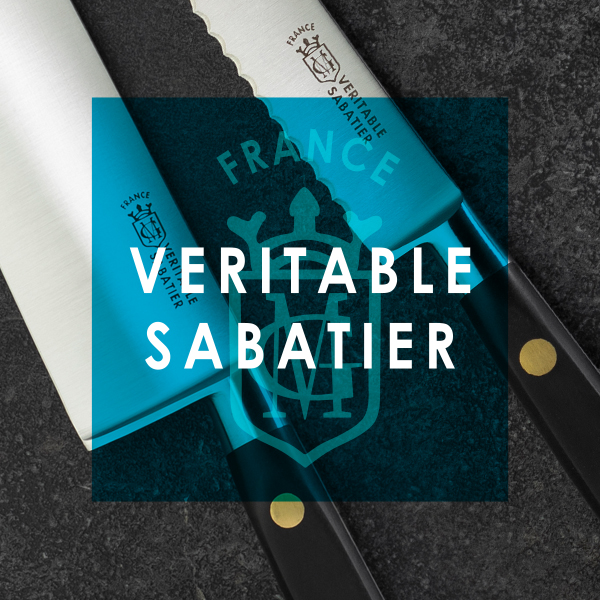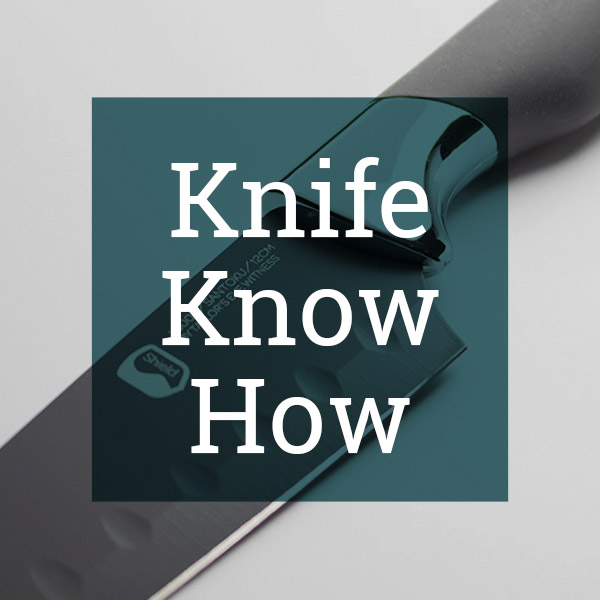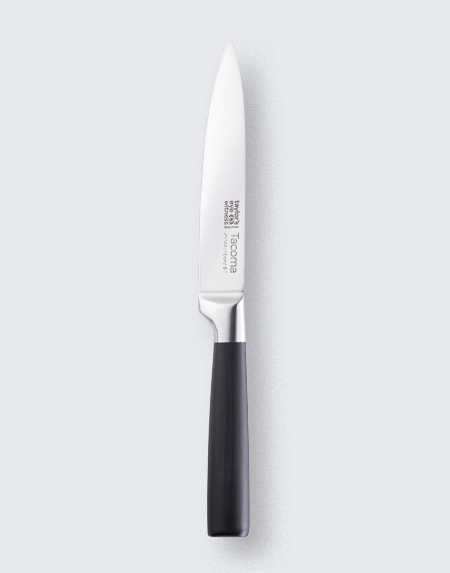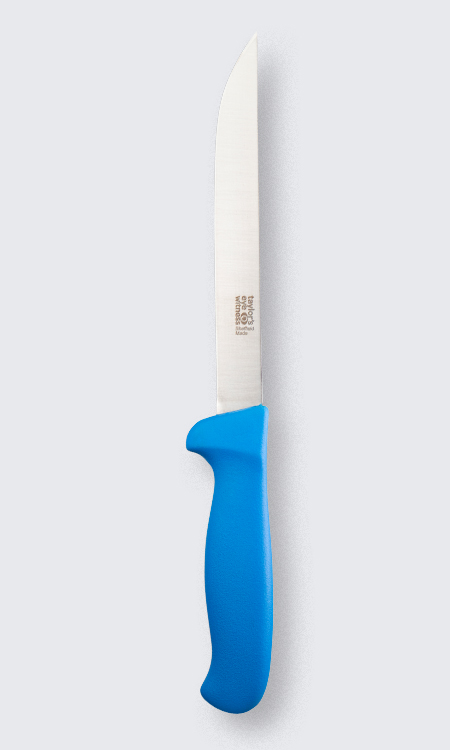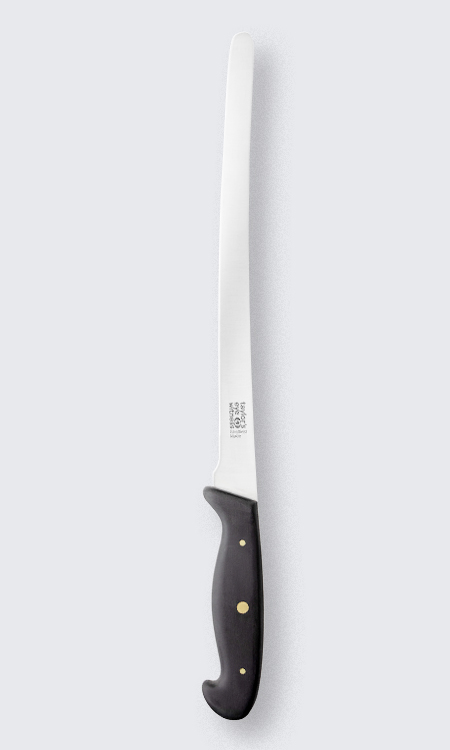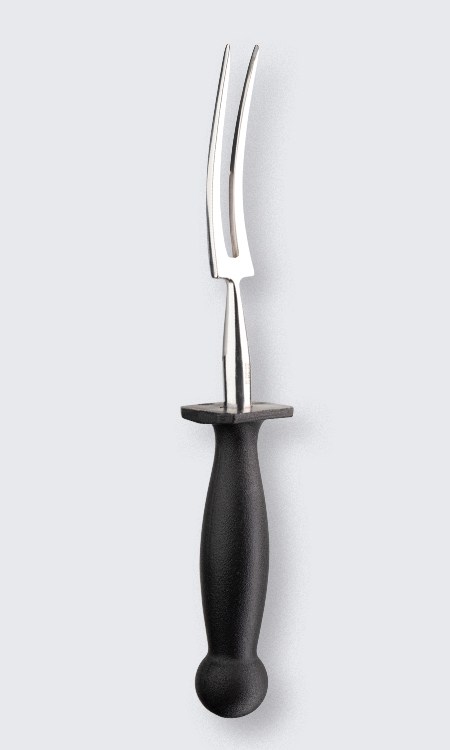Knife Know-How
What Taylor's doesn't know about knives isn't really worth knowing. Here we share with you what's important when choosing a knife and which knives no kitchen should be without.
Types of Construction
There are essentially six methods of kitchen knife manufacture, each imparting different properties in terms of performance, appearance & cost.

Fully Forged
A genuine fully-forged knife - such as one from our Veritable Sabatier range - is made from a single billet of steel that is formed with drop hammers to define the shape of the blade, bolster and handle. After forging and heat-treating, the handle material is moulded onto the tang, then the blade is polished and sharpened. Offers exceptional performance, strength and balance, favoured by professional chefs.

Full Tang Riveted
A centuries-old design, the classic Full-Tang, Triple Rivet knife is made with a stamped steel blade that is individually heat treated and tempered for excellent edge retention. Left and right 'scales' - made from wood, plastic or micarta - are riveted on either side of the blade. The whole knife is then polished back for a seamless finish. Lower cost than a fully forged knife, but with similar balance and performance qualities.

All Steel
When making a hollow handle knife, stainless steel pressings are welded to the blade, then the joints are ground and polished back to a smooth finish. Being completely seamless and free of food traps, this type of construction is hygienic and requires very little maintenance. The hollow void inside the handle is often filled with sand or steel weights to fine-tune the knife's balance characteristics.

Japanese 'Wa' Handle
The Japanese style 'Wa' handle is characterised by a metal ferrule near the blade which prevents the traditionally wooden handle from splitting. The blade 'tang' extends ½ to ¾ of the length of the handle providing some weight, though this type of knife typically has a blade-forward balance. Like a broom handle, this traditional design meant that the handle could be easily replaced throughout the life of the blade.

Moulded-On Handle
As the name suggests, the polymer handle is moulded directly over the near-finished blade. This results in a very resilient knife to withstand even the most demanding of environments. This type of knife is favoured particularly by professional chefs, butchers and commercial food producers owing to its easy maintenance, durability, lack of food traps and the ability to colour-code the handle.

Push-On Handle
Many modern knives feature push-on or 'hafted' handles that allow for creative finishes and designs that would not be possible by other methods. In some processes, after insertion of the blade the 'tang' is warmed by inductive heating to melt the polymer handle firmly onto the blade. Push-on knives are generally lower cost, light weight and have the added benefit of consistent quality and performance.
Blade Materials
Stainless steel is a popular class of material for knife blades because it resists corrosion and is easy to maintain. A simple wash and wipe dry is generally all it takes. It is not completely impervious to corrosion or rust, but any stain spots or small rust marks that do occur can be polished out with a good quality stainless steel cleaner and a soft cloth.
There are a number of different grades of Stainless Steel we use in our knives, each with different properties that we exploit depending on application. The key consideration when selecting the most appropriate steel is the hardness that can be achieved through heat treatment. A blade with very high hardness keeps an edge longer, but is more difficult to sharpen at home and will be considerably more expensive.
Our 'Sheffield Choice' and 'Heritage Series' ranges are made using 420HC steel, which is normally used in the manufacture of razor blades and scalpels. With between 0.4% and 0.5% carbon, it has the highest carbon content in its class, which makes a tough, readily hardenable blade that can be sharpened & maintained easily at home. Our heat treatment process achieves a hardness of up to 56 HRC on the Rockwell hardness scale. Items from the 'Professional Series' and 'Trade Tools' ranges are made in Sheffield with a grade of French stainless steel known as T5Mo - a Molybdenum alloy with 0.45% and 0.55% carbon.
Super-premium knives in our Sheffield Made range are made with Sandvik 14C28N® martensitic blade steel. The addition of nitrogen into the alloy in place of carbon leads to exceptional corrosion resistance. With unrivalled corrosion resistance and a typical hardness of 60 HRC, this super steel is used to make some of the finest kitchen and sports knives in the world.
Further afield, VG-10 stainless steel is a core feature of our Japanese-made kai knives. VG-10 is an exotic alloy with a very high carbon and chromium content for exceptional blade hardness and stain resistance. This steel grade is often used in the manufacture of 'Damascus' steel. Damascus knives feature a blade 'core' made with VG-10. This core is sandwiched between 66 layers of premium blade steel. This process exploits the best properties of each of the steel alloys for the ideal combination of hardness, flexibility & corrosion resistance. When the blade is ground to the classic convex “hamaguriba” taper profile, the minute variations in the thickness of these layers reveal the stunning pattern characteristic of Damascus steel.
Last but by no means least, knives in the Sabatier Professional family are made with molybdenum steel alloy and can be identified by the 'X50CrMoV15' blade etching. This is a high quality all-rounder with very good hardness and stain resistance without breaking the bank.
Hardening & Tempering
The hardenable varieties of Stainless Steel are generally supplied to the factory in the soft state to allow working of the material into its basic shape either by stamping or forging. Hardening involves heating the blade to between 1020° & 1040°C before cooling it rapidly. The process alters the crystalline structure of the steel making the blade extremely hard. This process is usually followed by tempering - a soak at approximately 200°C - which takes out a little of the hardness to de-stress the steel, making it less brittle and slightly flexible.

Edge Types
There are several common types of blade grinding techniques, all intended to thin the blade edge without compromising strength. Most blades are then given a plain edge - which requires periodic sharpening at home - or are given serrations for specific cutting tasks.

Taper Grind
A symmetrical wedge shaped profile is ground through the breadth of the blade. Results in a very fine edge that will retain it's sharpness well, without sacrificing the overall strength of the blade. Requires considerable skill to produce.

Asymmetrical Hollow Grind
Typical of many traditional Japanese knives, the main body of the blade is flat, while a chisel grind is taken from the right-hand side of the blade. The opposite side of the blade - while appearing flat - has a slight concave grind.

Symmetrical Hollow Grind
A concave grind is taken from a portion of the blade to thin the edge before sharpening. This process results in a very durable edge and permits the use of thinner steels for improved cutting performance & flexibility.

Blade 'Kullens'
Typical of Japanese style santoku knives, these concave air pockets are ground into both sides of the blade with the aim of reducing sticking & drag while slicing & chopping.

Fine Serrated Edge
Peaks and troughs are ground to one side of the knife. The peaks provide the initial cut, while protecting the troughs from damage. Ideal for tender foods, stringy vegetables, dried foods and tough, sinewy meats.

Scalloped Edge
Broad, saw-like scallops ground on a single side of the blade. Designed to zip through crusty bread, reducing the amount of pressure required thus reducing the chance of crushing the soft centre.
Kitchen Knife Types
Selecting the best tool for the job will make all your food preparation jobs quicker, easier and safer.
 Arabic
Arabic  Chinese
Chinese  English
English  French
French  German
German  Portuguese
Portuguese  Spanish
Spanish  Swedish
Swedish 


